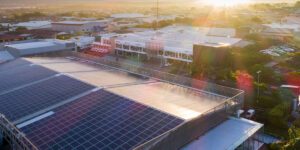What does Distributed Generation, Self-Consumption and Simple Net Generation mean? – Written by: editorial staff
Source: Energy National Plan 2015-2030 from Costa Rica’s Energy and Enviornmental Ministry
 For many years the traditional way to provide energy to consumers has been through big centralized energy generation plants from where energy is transmited and distributed to the country. For example, a hydroelectric plant is located at a river, generates the energy there and transmits it through electric towers or other resources to the infrastructure of the local grids or public electric companies (utility poles and power lines), and then it is finally delivered to the consumption site (companies, houses, businesses, warehouses, etc).
For many years the traditional way to provide energy to consumers has been through big centralized energy generation plants from where energy is transmited and distributed to the country. For example, a hydroelectric plant is located at a river, generates the energy there and transmits it through electric towers or other resources to the infrastructure of the local grids or public electric companies (utility poles and power lines), and then it is finally delivered to the consumption site (companies, houses, businesses, warehouses, etc).
Frequently the energy generation of this traditional model comes from non-renewable sources such as fossil fuels (highly pollutant) or from renewable sources such as hydroelectric which are not clean sources, since its production process and value chain can highly impact ecosystems and the environment. Building a hydroelectric plant implies intervening forests, rivers, natural resources such as water, among others.
With the advance of time and technology, other ways to generate electricity take place such as solar energy, wind power, biomass, among others, which are clean energies since they don’t have negative impacts in there value chain or are easy to mitigate or compensate in a positive way. These types of technologies generate electric power for self-consumption: this term is known as distributed generation. A building with photovoltaic solar energy has its modules on the roof, generates electricity during the day and consumes it at the moment or when needed.
Technologies that are taken into account inside the Distributed Generation frame are those that are interconnected to the grid (on-grid) with the goal of substituting part of the energy that would normally been taken from the grid. Self-consumption is when a consumer installs a photovoltaic solar system, generates part of the electricity he or she needs and takes the rest from the grid.
It is common that the consumer will not need to use the electricity at the moment when it is being generated so it is sent to the grid in order to “save it or store it” there. In Costa Rica, distribution companies charge the consumer a “toll” in order to use the stored energy. Finally, the distribution company quantifies the received energy, in order to discount it from the monthly bill, so that the consumer would have to pay only the net consumed, this term is know as Simple Net Generation with no sale of surplus. Why without sale of surplus? Because if a house produces more energy that what it needed and it has a positive balance but never used it, that consumer can not sell that surplus to the grid or distribution company and looses it. So for this reason it is very important that a system is designed to perfection to loose as little energy as posible.
